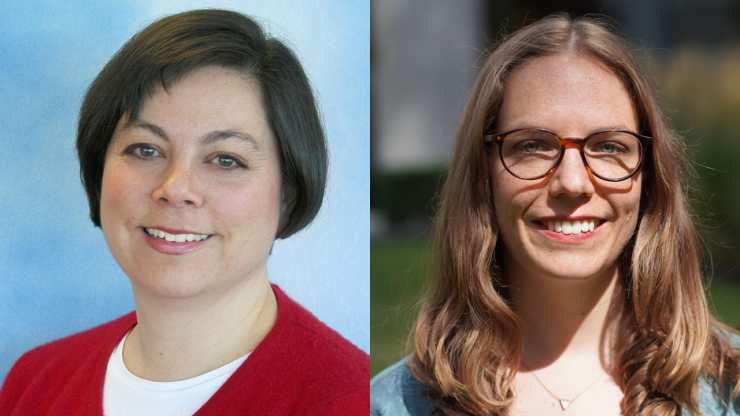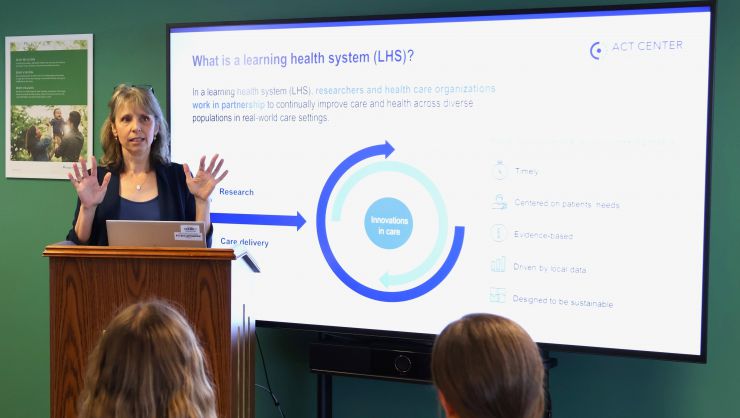Accelerating qualitative research with the Rap-GAP method

Clarissa Hsu (left) and Jess Mogk, ACT Center partners and coauthors of a recent paper sharing the new Rapid Group Analysis Process (Rap-GAP) method for qualitative research.
Clarissa Hsu and Jess Mogk share a new way for learning health systems to fast-track insights from qualitative data
Q&A with Associate Investigator Clarissa Hsu, PhD, and Collaborative Scientist Jess Mogk, MPH, collaborators in the Center for Accelerating Care Transformation (ACT Center) at Kaiser Permanente Washington Health Research Institute (KPWHRI)
Qualitative research — such as conducting focus groups and interviews with patients and providers — can yield rich results to help guide evidence-based strategies for improving health care and health policy. But with health care practices and policies constantly changing, many qualitative methods and analytic processes can’t match the speed at which health care decision-makers must act.
To help meet this challenge, Clarissa Hsu, PhD, an associate investigator at KPWHRI and longtime ACT Center partner, led the development of the Rapid Group Analysis Process (Rap-GAP) — a new method for qualitative analysis that’s faster and more efficient than existing approaches, while also elevating diverse voices in the process. Her team included KPWHRI Collaborative Scientists Laurel Hansell, MA, MPH, and Jess Mogk, MPH, who leads several projects for the ACT Center — as well as Claire Allen, MPH, who manages KPWHRI’s Collaborative Science Division and co-leads strategy and operations for the ACT Center.
Published recently in the International Journal of Qualitative Methods, Rap-GAP is a standalone qualitative analysis method for rapidly coding, interpreting, and summarizing key insights from qualitative transcripts and other qualitative data sources. And because the method is built for a virtual environment, research teams can leverage online tools to enhance the quality and speed of the analytic process.
In their recent paper, the Rap-GAP team describes the 5-step method and illustrates how to use and adapt it via 3 case studies, including an evaluation conducted as part of Kaiser Permanente Washington’s Learning Health System Program. The paper also includes a link to the Rap-GAP instruction manual, which is publicly available in the ACT Center’s resource library. In this Q&A, Clarissa and Jess share more about what makes Rap-GAP unique and how other learning health systems (LHSs) can use it to inform timely, evidence-based decisions.
What makes Rap-GAP unique among qualitative research methods?
Clarissa Hsu (CH): Rap-GAP builds on many different ideas from rapid qualitative analysis, but we created it to be faster than traditional approaches. It’s designed around 5 specific and clearly outlined steps that others can easily replicate while building meaningful group discussion into their analysis. So it allows researchers to incorporate important perspectives from the people directly involved in or affected by the questions being studied.
Jess Mogk (JM): Another thing that makes Rap-GAP unique is that it’s a virtual method. It wasn't first conceptualized that way, but the first time we used it was during the early days of the COVID-19 pandemic. So we had to leverage online tools, and that ended up making the process even more efficient. Clarissa had always envisioned a fun, engaging process. But we learned that using interactive and intuitive online resources helped us bring in lots of people to participate — and that they were enthusiastic about it. So I think Rap-GAP’s superpower is being both rapid and engaging, which makes it easier to incorporate diverse perspectives.
CH: I agree that being able to maximize online tools has made the method more powerful and efficient than we ever thought it could be. It has allowed us to engage more people in the sense-making process, including people who don’t have formal training in qualitative analysis. Plus, it has a great name, and many of the people we have engaged in a Rap-GAP analysis have noted how fun it is to participate, which I think is rare when talking about qualitative analysis.
What inspired you to write the paper and share the method with other researchers?
CH: I was a little hesitant to pursue a methods paper at first. But Jess and our ACT Center colleague Claire Allen were very enthusiastic about sharing Rap-GAP with others — especially since it supports the rapid learning and improvement that learning health systems like Kaiser Permanente Washington are aiming for. It was definitely ACT Center’s enthusiasm and support that propelled the paper forward. At the same time, we were learning so much each time we used the method. We have used Rap-GAP in more than 6 projects to date, and each time we’ve come away with concrete ideas for improving the steps and the instructions, as well as advice for how others can adapt it for different environments. In several projects, we adapted the method for different phases of the analysis process and found it to be highly flexible.
JM: We also found that we just really liked the method. Once it was available, we kept wanting to use it for upcoming projects. And as new people tried it, we would always get a lot of positive feedback. It seemed clear that this was a resource worth sharing. To supplement the paper, we developed a publicly available Rap-GAP instruction manual that provides a workflow diagram, a summary of technical tasks for operating in a virtual environment, and a set of example emails and agendas that users can adapt.
CH: We’re currently exploring ways to share Rap-GAP more broadly, including with our colleagues at the Kaiser Permanente Bernard J. Tyson School of Medicine and at national research conferences. We’re also open to presenting Rap-GAP as a workshop to qualitative research groups or LHS teams who might be interested. If you’re reading this and want to learn more, feel free to email me! (clarissa.w.hsu@kp.org)
What makes Rap-GAP particularly useful in learning health systems?
JM: In a typical LHS environment, leaders often have to make decisions quickly — which means they may not be able to wait 6 months to a year (or longer) for in-depth findings from qualitative data. Rap-GAP provides the benefit of being both rapid and rigorous. Despite being a faster method, it still elevates direct quotes from patients, care teams, and health care leaders — which surfaces essential perspectives that LHSs are trying to prioritize. Rap-GAP is also important because it engages leaders and clinicians in more deeply understanding the findings that they will be accountable for championing to achieve successful implementation.
CH: In some cases, a project might require the additional rigor that comes with traditional methods. But Rap-GAP works really well when having faster access to qualitative data is a top priority. We are currently working on comparing traditional qualitative analysis to Rap-GAP in terms of capturing themes, nuances, and insights. This next step will help us better advise on when to use Rap-GAP versus traditional qualitative analysis approaches.
JM: The ACT Center is also continuing to use Rap-GAP in our LHS Program projects at Kaiser Permanente Washington. One example is our evaluation of the new Self-Collect HPV Program, which gives members the option of completing cervical cancer screening using a self-collection kit provided by mail or in the clinic. We know from recent KPWHRI research that this option boosts screening rates and that most people have positive experiences with it. So now we need to better understand how to optimize the implementation of the program at Kaiser Permanente Washington. We’re planning to use Rap-GAP to analyze qualitative data from site visits and interviews and will include care team members in the process. Using Rap-GAP means we can provide timely insights to help Kaiser Permanente Washington efficiently spread, enhance, and sustain an evidence-based program that will improve care and services for our members.
Read the paper here: Rapid Group Analysis Process (Rap-GAP): A Novel Approach to Expedite Qualitative Health Research Data Analysis.
Clarissa and Jess’s co-authors are KPWHRI’s Joe Glass, PhD, MSW; Laurel Hansell, MA, MPH; and Claire Allen, MPH.
Learn more
Interested in hosting a Rap-GAP workshop? Email Clarissa Hsu: clarissa.w.hsu@kp.org.

